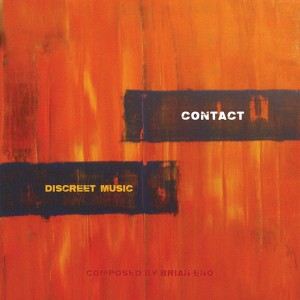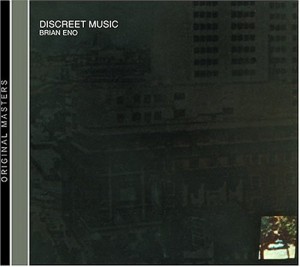Brian Eno's Discreet Music Makes Acoustic Contact.
Contact is the latest ensemble to take composer Brian Eno’s ambient electronic works and arrange them for live players. They turn Eno’s Discreet Music, into an immersive meditation. You need to set aside one hour of time, make that time free of disturbance and make yourself comfortable, but alert. And you’ll want to have a good stereo system cranked, or a good set of headphones. Only then might you be ready to experience the beauty of Contact’s take on Brian Eno’s Discreet Music.
You need to set aside one hour of time, make that time free of disturbance and make yourself comfortable, but alert. And you’ll want to have a good stereo system cranked, or a good set of headphones. Only then might you be ready to experience the beauty of Contact’s take on Brian Eno’s Discreet Music.
Forty years ago, no one ever suspected that Brian Eno’s ambient works would make such beautiful vehicles for acoustic ensembles. Music for Airports and Apollo-Atmospheres and Soundtracks were originally conceived with either loops of overlapping repeating patterns or with mostly electronic instruments, yet both have been magnificently covered by acoustic ensembles, Bang on a Can All-Stars and Icebreaker respectively. Now “Discreet Music,” arguable the first of Eno’s ambient works, has entered the acoustic canon, all of which are on Bang On A Can’s Cantaloupe label.
Contact is a performance unit specializing in modern music from avant-garde to pop. A quick sample of their repertoire includes works Aphex Twin, David Bowie, Gavin Bryars, John Cage, Philip Glass and Terry Riley, pretty much the panoply of post minimalist classical and avant-pop music.
 So it makes sense that in the footsteps of new music groups, Bang on a Can and Icebreaker, that they would be drawn to the work of Brian Eno. But unlike those groups they’ve selected one of Eno’s most austere works, the seminal ambient composition, “Discreet Music,” to interpret for mostly acoustic instruments.
So it makes sense that in the footsteps of new music groups, Bang on a Can and Icebreaker, that they would be drawn to the work of Brian Eno. But unlike those groups they’ve selected one of Eno’s most austere works, the seminal ambient composition, “Discreet Music,” to interpret for mostly acoustic instruments.
On one hand, “Discreet Music” is the least likely work for an acoustic treatment given its roots in the tape-loop feedback system Eno created for it in 1975. Playing a couple of short melodic fragments on an EMS Synthi AKS, he ran them through an equalizer, some echoes and into a tape machine. The tape runs to the take-up reel of a second machine and the output of that machine is fed back into the first tape machine which records the overlapped signals ad infinitum. It sounds simple and possibly a little boring, but instead it is a mesmerizing journey: a slow flow down a river of melodic invention.
Contact vibraphonist Jerry Pergolesi has taken those ensuing melodies and layers upon layers of sound and transposed them to the nine piece group, Contact. It’s an acoustic ensemble of cello, violin, soprano saxophone, guitar, double bass, vibraphone, piano, flute and gongs with a guitar as the one electric outlier.
Eno always claimed this was music for the background, but when I put the CD on in the office, instead of fading into the environment, it pulled me into its slowly undulating waves that move like radar slowly scanning the skies. Pergolesi hasn’t created a note-for-note rendition, but an acoustic re-imagining that expands the piece out to 60 minutes from its original 31.
 As Contact’s Discreet Music moves on, the melodies shift from instrument to instrument, sometimes creating counterpoints, echo delays and merging into harmonies in an infinite canon. (Eno’s original Discreet Music album also had a looping rendition of Pachelbel’s “Canon.”) While Eno relied on just a few synthesizer timbres, Pergolesi’ rendition has nine distinctive voices, maybe more if you include the different effects of Rob MacDonald’s electric guitar. This could rob the work of its pristine austerity, but instead, it enhances it, making it even deeper and richer.
As Contact’s Discreet Music moves on, the melodies shift from instrument to instrument, sometimes creating counterpoints, echo delays and merging into harmonies in an infinite canon. (Eno’s original Discreet Music album also had a looping rendition of Pachelbel’s “Canon.”) While Eno relied on just a few synthesizer timbres, Pergolesi’ rendition has nine distinctive voices, maybe more if you include the different effects of Rob MacDonald’s electric guitar. This could rob the work of its pristine austerity, but instead, it enhances it, making it even deeper and richer.
Brian Eno’s original Discreet Music was recorded 40 years ago and Contact’s ensemble rendering is another example of the timeless nature of Eno’s compositions. So take the time. Immerse yourself in this journey. You’ll be different at the end.
~John Diliberto

Enthralling! It was like having a sonic sieve
un-discombobulate & reconfigure me anew.
Am grabbing a copy of this CD luckity-split…
to use as ambient music for doing artwork, writing, meditation, and making love: YUM!